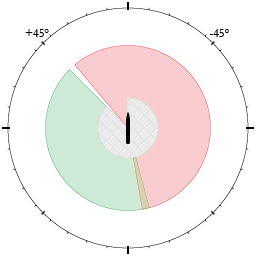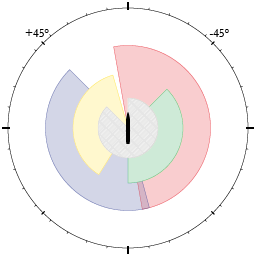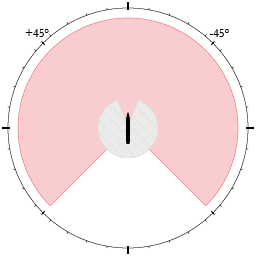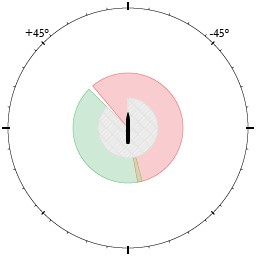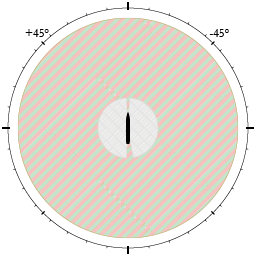DCS Reference: Ships, Western
Many carrier aircraft have somewhat contradictory definitions, or definitions of unclear value, as far as their carrying capacity. They may list only having 4 parking spots and a max number of aircraft or helicopters, in one sense, but then have coordinates set for over a dozen different parking spots on the deck. The blocks below distinguish between these two by calling them “nominal” and “defined” limits, where the nominal parking limit at most seems to correlate to how many different aircraft can be designated as “start on runway” in the mission editor.
The defensive arcs show the areas around the ship where specific defensive systems have full range of movement. This does not mean that areas that are not covered are safe — rather that the ship systems will be limited in their effectiveness because ship decks, conning towers, or bridges are in the way. However, given enough elevation, they can usually shoot over such obstructions, and only low-altitude skimming creates the coverage gaps demonstrated. In addition, depending on the guidance system of the weapon, they may be lofted above obstacles if the target is far enough away, which means that the “safe zone” only exists at low altitude and at close range.
Up to four range layers are shown in the arc sketches: close-range protection (from CIWS and simular systems); short-range protection, usually from IR-guided missiles; medium-range protection, usually from less advanced radar missiles; and long-range protection.
Since all ships only use a handful of weapon systems, the two are presented separately to reduce the amount of repetition.
Ships
Arleigh Burke-class Destroyer
| Mission Editor Unit | Function | Stores | Range / Symbol | |
|---|---|---|---|---|
| USS Arleigh Burke IIa (Supercarrier) | Guided-missile (AEGIS) destroyer | 16+48× RIM-66 Standard Missile 2 2× 1550× 20mm Phalanx 2× 230× 25mm Bushmaster 1× 180× 127mm Mk45 2× 16× BGM-109 Tomahawk |
Detection: 0–80.1nm / 0–150km Detection alt.: 0–343,500ft / 0–104,700m[2] Engagement: 0–54.0nm / 0–100km Engagement alt.: 16.5–98,400ft / 5–30,000m | |
| Hit points | 2,100 | Max speed | 15.6m/s (30.2kts, 56.0km/h) | Defensive arcs |
| Sensor limits[3] | Surface radar: 360° horizontal × -5°–+10° vertical; 12s scan time. SS lock-on: 18.9nm / 35km. Notch: <15m/s (29kts, 54km/h) vrad. AA radar: 360° horizontal × -15°–+60° vertical. AA lock-on: 119.3nm / 221km. Notch: <15m/s (29kts, 54km/h) vrad. AEGIS trackers can guide 2 missiles per target at 9 targets at a time; lock-on time 2s. Target size limit: 0.1m².[4] |
|||
| Carrying capacity | 1 defined helicopter parking spots. 2 helicopter nominal capacity. | |||
| Notes | ||||
| Acts as a warehouse to deliver stores to other units and to landed aircraft. Per the internal definitions, it cannot re-arm its own weapon stores once depleted.
Is internally defined to allow attacks against targets up to 243nm / 450km away, presumably to allow for Tomahawk targeting. Requires the Supercarrier module to control and/or add to missions. | ||||
| Available to | ||||
Forrestal-class Carrier
| Mission Editor Unit | Function | Stores | Range / Symbol | |
|---|---|---|---|---|
| CV-59 USS Forrestal[5] | Carrier | 2× 8× RIM-7 Sea Sparrow 3× 1550× 20mm Phalanx |
Detection: 0–16.2nm / 0–30km Detection alt.: 0–75,400ft / 0–23,000m[2] Engagement: 0.2–16.2nm / 0.4–30km Engagement alt.: 16–49,200ft / 5–15,000m | |
| Hit points | 7,300 | Max speed | 18.4m/s (35.8kts, 66.3km/h) | Defensive arcs |
| Sensor limits | Surface radar: 360° horizontal × -5°–+10° vertical; 12s scan time. SS lock-on: 21.1nm / 39km. Notch: <15m/s (29kts, 54km/h) vrad. AA Radar: 360° horizontal × -15°–+60° vertical; 1s scan. AA lock-on: 13.8nm / 25.5km. Notch: <10m/s (19kts, 36km/h) vrad. Target size limit: 0.1m².[4] |
|||
| Carrying capacity | 4 defined aircraft parking spots. 8 defined helicopter parking spots. 2+2 catapults. 4 nominal spawn points. 72 aircraft + 6 helicopter nominal capacity. | |||
| Notes | ||||
| This unit is half-defined in an unfinished state as part of the F-14 module. It has not been integrated in such a way that it is available as a selectable unit in the mission editor, nor does a 3D model exist should the files be altered to make it one. The stats presented here represent the unit and its systems as they are defined in its current state.
The unit itself is named CV-59 Forrestal, but is internally also using the CV-60 name, which corresponds to how many other ship definitions use the lead ship of the class to name the unit and then have a different hull number be the source of the actual in-game model layout and capabilities. | ||||
| Available to | ||||
| None. | ||||
Nimitz-class Carrier
Nimitz subclass
| Mission Editor Unit | Function | Stores | Range / Symbol | |
|---|---|---|---|---|
| CVN-70 Carl Vinson | Carrier | 3× 8× RIM-7 Sea Sparrow 4× 1550× 20mm Phalanx |
Detection: 0–16.2nm / 0–30km Detection alt.: 0–75,400ft / 0–23,000m[2] Engagement: 0–8.1nm / 0–15km Engagement alt.: 0–37,700ft / 0–11,500m[2] | |
| Hit points | 7,300 | Max speed | 15.4m/s (29.9kts, 55.5km/h) | Defensive arcs |
| Sensor limits | Surface radar: 360° horizontal × -5°–+10° vertical; 12s scan time. SS lock-on: 21.1nm / 39km. Notch: <15m/s (29kts, 54km/h) vrad. AA Radar: 360° horizontal × -15°–+60° vertical; 1s scan. AA lock-on: 13.8nm / 25.5km. Notch: <10m/s (19kts, 36km/h) vrad. No target size limit is defined that would affect its ability to engage incoming air weapons. |
|||
| Carrying capacity | 13 defined aircraft parking spots. 5 defined helicopter parking spots. 2+2 catapults (1+1 can be used safely in parallel). 4 nominal spawn points. 72 aircraft + 6 helicopter nominal capacity. | |||
| Notes | ||||
| Acts as a warehouse to deliver stores to other units and to landed aircraft. Per the internal definitions, it cannot re-arm its own weapon stores once depleted.
Not compatible with the AV-8B NA Harrier. | ||||
| Available to | ||||
Theodore Roosevelt sub-class (Basic)
| Mission Editor Unit | Function | Stores | Range / Symbol | |
|---|---|---|---|---|
| CVN-74 John C. Stennis | Carrier | 2× 8× RIM-7 Sea Sparrow 3× 1550× 20mm Phalanx |
Detection: 0–16.2nm / 0–30km Detection alt.: 0–75,400ft / 0–23,000m[2] Engagement: 0.2–8.1nm / 0.4–15km Engagement alt.: 15–49,200ft / 5–15,000m | |
| Hit points | 7,300 | Max speed | 15.4m/s (29.9kts, 55.4km/h) | Defensive arcs |
| Sensor limits | Surface radar: 360° horizontal × -5°–+10° vertical; 12s scan time. SS lock-on: 21.1nm / 39km. Notch: <15m/s (29kts, 54km/h) vrad. AA radar: 360° horizontal × -15°–+60° vertical; 1s scan. AA radar lock-on: 13.8nm / 25.5km. Notch: <10m/s (19kts, 36km/h) vrad. Mk95 trackers can engage 4 targets at a time with 1 missile each; lock-on time 2.5s. Size limit: 0.1m².[4] |
|||
| Carrying capacity | 19 defined aircraft parking spots. 8 defined helicopter parking spots. 2+2 catapults (1+1 can be used safely in parallel). 4 nominal spawn points. 72 aircraft + 6 helicopter nominal capacity. | |||
| Notes | ||||
| Acts as a warehouse to deliver stores to other units and to landed aircraft. Per the internal definitions, it cannot re-arm its own weapon stores once depleted.
The engagement limits only apply to the Mk95 trackers used to guide RIM-7 Sea Sparrows. Not compatible with the AV-8B NA Harrier. | ||||
| Available to | ||||
Theodore Roosevelt sub-class (Supercarrier)
| Mission Editor Unit | Function | Stores | Range / Symbol | |
|---|---|---|---|---|
| CVN-71 Theodore Roosevelt CVN-73 George Washington CVN-75 Harry S. Truman (Supercarrier) |
Carrier | 2× 8× RIM-7 Sea Sparrow 2× 21× RIM-116 RAM 2× 1550× 20mm Phalanx |
Detection: 0–16.2nm / 0–30km Detection alt.: 0–75,400ft / 0–23,000m[2] Engagement: 0.2–16.2nm / 0.4–30km Engagement alt.: 15–49,200ft / 5–15,000m | |
| Hit points | 7,300 | Max speed | 15.4m/s (29.9kts, 55.4km/h) | Defensive arcs[6] |
| Sensor limits | Surface radar: 360° horizontal × -5°–+10° vertical; 12s scan time. SS lock-on: 21.1nm / 39km. Notch: <15m/s (29kts, 54km/h) vrad. AA radar: 360° horizontal × -15°–+60° vertical; 1s scan. AA radar lock-on: 13.8nm / 25.5km. Notch: <10m/s (19kts, 36km/h) vrad. Mk95 trackers can engage 3 targets at a time with 1 missile each; lock-on time 2.5s. Size limit: 0.1m².[4] |
|||
| Carrying capacity | 19 defined aircraft parking spots. 8 defined helicopter parking spots. 2+2 catapults (2+2 can be used safely in parallel). 4 nominal spawn points. 72 aircraft + 6 helicopter nominal capacity. | |||
| Notes | ||||
| Acts as a warehouse to deliver stores to other units and to landed aircraft. Per the internal definitions, it cannot re-arm its own weapon stores once depleted.
The engagement limits only apply to the Mk95 trackers used to guide RIM-7 Sea Sparrows. Not compatible with the AV-8B NA Harrier. Requires the Supercarrier module to use, control, and/or add to missions. The different hulls only differ in terms of aesthetics and placement of on-board decorations. | ||||
| Available to | ||||
| Mission Editor Unit | Function | Stores | Range / Symbol | |
|---|---|---|---|---|
| CVN-72 Abraham Lincoln (Supercarrier) | Carrier | 2× 8× RIM-7 Sea Sparrow 2× 21× RIM-116 RAM 3× 1550× 20mm Phalanx |
Detection: 0–16.2nm / 0–30km Detection alt.: 0–75,400ft / 0–23,000m[2] Engagement: 0.2–16.2nm / 0.4–30km Engagement alt.: 15–49,200ft / 5–15,000m | |
| Hit points | 7,300 | Max speed | 15.4m/s (29.9kts, 55.4km/h) | Defensive arcs[6] |
| Sensor limits | Surface radar: 360° horizontal × -5°–+10° vertical; 12s scan time. SS lock-on: 21.1nm / 39km. Notch: <15m/s (29kts, 54km/h) vrad. AA radar: 360° horizontal × -15°–+60° vertical; 1s scan. AA radar lock-on: 13.8nm / 25.5km. Notch: <10m/s (19kts, 36km/h) vrad. Mk95 trackers can engage 3 targets at a time with 1 missile each; lock-on time 2.5s. Size limit: 0.1m².[4] |
|||
| Carrying capacity | 19 defined aircraft parking spots. 8 defined helicopter parking spots. 2+2 catapults (2+2 can be used safely in parallel). 4 nominal spawn points. 72 aircraft + 6 helicopter nominal capacity. | |||
| Notes | ||||
| Acts as a warehouse to deliver stores to other units and to landed aircraft. Per the internal definitions, it cannot re-arm its own weapon stores once depleted.
The engagement limits only apply to the Mk95 trackers used to guide RIM-7 Sea Sparrows. Not compatible with the AV-8B NA Harrier. Requires the Supercarrier module to use, control, and/or add to missions. Differs from the other Theodore Roosevelt supercarriers in having a third aft CIWS and a wider front Sea Sparrow engagement arc. | ||||
| Available to | ||||
Oliver Hazard Perry-class Frigate
| Mission Editor Unit | Function | Stores | Range / Symbol | |
|---|---|---|---|---|
| Oliver Hazard Perry class | Guided-missile frigate | 1× 24× RIM-66 Standard Missile 2 1× 1550× 20mm Phalanx 4× 100× 12.7mm M2 2× 230× 25mm Bushmaster 1× 180× 76mm Mk75 1× 16× RGM-84 Harpoon |
Detection: 0–80.1nm / 0–150km Detection alt.: 0–253,500ft / 0–77,100m[2] Engagement: 0–54.0nm / 0–100km Engagement alt.: 0–210,900ft / 0–64,300m[2] | |
| Hit points | 2,300 | Max speed | 14.9m/s (29.0kts, 53.6km/h) | Defensive arcs |
| Sensor limits[3] | Surface radar: 360° horizontal × -5°–+10° vertical; 12s scan time. SS lock-on: 18.2nm / 33.6km. Notch: <15m/s (29kts, 54km/h) vrad. AA radar: 360° horizontal × -15°–+60° vertical. AA lock-on: 119.3nm / 221km. Notch: <15m/s (29kts, 54km/h) vrad. Mk92 tracker can engage 1 targets at a time; lock-on time 10s. No target size limit is defined that would affect its ability to engage incoming air weapons. |
|||
| Carrying capacity | 1 defined helicopter parking spots. 2 helicopter nominal capacity. | |||
| Notes | ||||
| Acts as a warehouse to deliver stores to other units and to landed aircraft. Per the internal definitions, it cannot re-arm its own weapon stores once depleted.
The Mk13 launch rail has a nominal readying time of 12s between missiles, but this is almost always swallowed up by the locking time and guidance of previous missiles, unless the enemy target is at very close range (in which case missiles are often not used at all). Is internally defined to allow attacks against targets up to 65.8nm / 120km away, presumably to allow for Harpoon targeting. | ||||
| Available to | ||||
Tarawa-class Amphibious Assault Ship
| Mission Editor Unit | Function | Stores | Range / Symbol | |
|---|---|---|---|---|
| LHA-1 Tarawa | Amphibious Assault Ship | 2× 21× RIM-116 RAM 2× 1550× 20mm Phalanx |
Detection: 0–81.0nm / 0–150km Detection alt.: 0–65,600ft / 0–20,000m Engagement: 0.2–16.2nm / 0.4–30km Engagement alt.: 16.4–49,200ft / 5–15,000m | |
| Hit points | 7,300 | Max speed | 15.4m/s (29.9kts, 55.4km/h) | Defensive arcs |
| Sensor limits | Surface radar: 360° horizontal × -5°–+10° vertical; 12s scan time. SS lock-on: 21.1nm / 39km. Notch: <15m/s (29kts, 54km/h) vrad. AA Radar: 360° horizontal × -15°–+60° vertical; 1s scan. AA lock-on: 13.8nm / 25.5km. Notch: <10m/s (19kts, 36km/h) vrad. Mk95 trackers can engage 2 targets at a time with one missile each; lock-on time 2.5s. Target size limit: 0.1m².[4] |
|||
| Carrying capacity | 8 defined aircraft parking spots. 9 defined helicopter parking spots. 4 nominal spawn points. 40 aircraft + 36 helicopter nominal capacity. | |||
| Notes | ||||
| Acts as a warehouse to deliver stores to other units and to landed aircraft. Per the internal definitions, it cannot re-arm its own weapon stores once depleted.
While later patches has toned them down somewhat, the detection and engagement ranges of the Tarawa are defined to be far higher than any of its sensors and weapon systems could possibly reach or make use of, causing the threat circles in the mission editor to be highly over-exaggerated. At best, they can be used as a very inaccurate indication of the effective range of any helicopters on board. The engagement ranges listed are what the on-board Mk95 tracking radar is actually capable of, which in turn exceeds what the actual weapon systems are capable of by a factor of ×2. It has been speculated that these exaggerated capabilities are in place to allow the ATC AI to be aware of landing aircraft, but nothing has been confirmed. Fully compatible with the AV-8B NA Harrier. | ||||
| Available to | ||||
Ticonderoga-class Cruiser
| Mission Editor Unit | Function | Stores | Range / Symbol | |
|---|---|---|---|---|
| Ticonderoga class | Guided-missile (AEGIS) cruiser | 2× 45× RIM-66 Standard Missile 2 2× 1550× 20mm Phalanx 3× 100× 12.7mm M2 2× 230× 25mm Bushmaster 2× 180× 127mm Mk45 2× 4× RGM-84 Harpoon 2× 16× BGM-109 Tomahawk |
Detection: 0–80.1nm / 0–150km Detection alt.: 0–426,200ft / 0–129,900m[2] Engagement: 0–54.0nm / 0–100km Engagement alt.: 16.5–98,400ft / 5–30,000m | |
| Hit points | 2,700 | Max speed | 15.4m/s (29.9kts, 55.4km/h) | Defensive arcs |
| Sensor limits[3] | Surface radar: 360° horizontal × -5°–+10° vertical; 12s scan time. SS lock-on: 18.9nm / 35km. Notch: <15m/s (29kts, 54km/h) vrad. AA radar: 360° horizontal × -15°–+60° vertical. AA lock-on: 119.3nm / 221km. Notch: <15m/s (29kts, 54km/h) vrad. AEGIS trackers can guide 2 missiles per target at 9 targets at a time; lock-on time 2s. Target size limit: 0.1m².[4] |
|||
| Carrying capacity | 1 defined helicopter parking spots. 2 helicopter nominal capacity. | |||
| Notes | ||||
| Acts as a warehouse to deliver stores to other units and to landed aircraft. Per the internal definitions, it cannot re-arm its own weapon stores once depleted.
Is internally defined to allow attacks against targets up to 243nm / 450km away, presumably to allow for Harpoon and Tomahawk targeting. | ||||
| Available to | ||||
Systems
These stats apply to the baseline version of the respective systems. Occasionally, different platforms will overwrite some values, such as ammunition capacity and engagement limits, by their own specific on-board limitations.
Phalanx CIWS
| System / function | Guidance | Stores | Range |
|---|---|---|---|
| Close-In Weapon System | Radar | 1550× 20mm AP+HE | Engagement: 0–1.94nm (11,800ft) / 0–3.6km Altitude: 0–6,500ft / 0–2,000m |
| Reload / rearm | RoF: 4500 rpm; cannot be rearmed once depleted. | ||
| Acquisition time | 1s | ||
| Acquisition limits | Target size: 0.05m².[4] | ||
| Aiming limits | Visual: ±150° horizontal × -25°–85° vertical. | ||
| Kill radius | N/A | ||
| Available on | |||
| CG-65, CVN-70, CVN-71, CVN-72, CVN-73, CVN-74, CVN-75, DDG-112, FFG-46, LHA-1 | |||
| Tactics | |||
| CIWS (“sea-wiz”) is the modern reinterpretation of flak: defeat just about anything, no matter how small or fast or low-flying, by simply putting up a wall of lead — something will connect and make things explode. Going up against it in something as huge and slow and lumbering as an aircraft is usually a fool's errand, and you have stand-off weapons for a reason. It is still a predicted-lead calculating system, however, so sufficiently erratic movements, especially in all three dimensions, will throw it off, but the question mostly remains: what are you going to do when you get that close to the ship? Drop high-drag dumb bombs on it?
Curiously enough, one of the best ways to defeat CIWS is very closely related: use smart bombs, tossed from a great distance and altitude, since that keeps you above the effective firing altitude of many defensive systems, and the bombs outside of the arc of the same systems, including CIWS. Smaller bombs, like GBU-38s and -32s will simply not be detectable by ship's systems — indeed, it is an open question which bombs, if any, are detectable at all by defensive systems outside of glide bombs such as JSOWs and LS-6 (but then, DCS internally treats those as missiles anyway). When using anti-ship missiles, some sort of terminal manoeuvre is usually needed to throw CIWS off its aim, be it pop-up or side-jink. The immense rate of fire combined with the (relative) low amount of available ammunition also makes it possible to simply overwhelm the system: usually, only one or two emplacement will be able to cover a given sector, and each will run out after just 20s of continuous firing. This usually translates into just 5 or 6 bursts per gun. | |||
RIM-7 Sea Sparrow
| System / function | Guidance | Stores | Range |
|---|---|---|---|
| Surface-ship launched Intercept-aerial guided Missile |
Semi-active radar | 8× RIM-7 | Engagement: 1.1–8.1nm / 2–15km Flight range: 0.8–14.8nm / 1.5–27.5km Altitude: 65.6–80,000ft / 20–24,400m Max speed: Mach: 3.0 |
| Reload / rearm | 2s to ready a new missile; cannot be rearmed once depleted. | ||
| Acquisition time | 3s | ||
| Acquisition limits | Target size limit: 0.02m².[4] | ||
| Aiming limits | Minimum launch elevation: 15°. | ||
| Kill radius | 10m | ||
| Notes | |||
| While notionally capable of engaging incoming missiles, the range and flight profile makes it unlikely that any shots will be made, or that any attempts will have an effect. | |||
| Available on | |||
| CVN-70, CVN-71, CVN-72, CVN-73, CVN-74, CVN-75 | |||
| Tactics | |||
| This is a navalised version of the AIM-7 Sparrow missile and can be defeated in much the same way. In addition to having a fairly high minimum target altitude, its launch elevation also means that it is entirely possible for a fast target to get in close before the missile has time to arc down for a good intercept. Of course, being this low, fast, and up-close will invariably put you in range of CIWS fire… | |||
RIM-66 Standard Missile 2
| System / function | Guidance | Stores | Range |
|---|---|---|---|
| Surface-ship launched Intercept-aerial guided Missile |
Semi-active radar | 15× SM-2 | Engagement: 2.2–54.0nm / 4–100km Low alt. flight range: 2.2–21.6nm / 4–40km High alt. flight range: 2.2–54.0nm / 4–100km Altitude: 32.8–80,000ft / 10–24,400m Max speed: Mach: 6.8 |
| Reload / rearm | 2s to ready a new missile; Cannot be rearmed once depleted. | ||
| Acquisition time | 1s | ||
| Acquisition limits | Target size limit: 0.1m².[4] | ||
| Aiming limits | None. | ||
| Kill radius | 15m | ||
| Available on | |||
| CG-65, DDG-112, FFG-46 | |||
| Tactics | |||
| For all intents and purposes, this is a naval Patriot battery, except it flies farther, higher, faster; delivers more boom at the end; and is usually backed up by a far more capable tracking system. While the baseline system “only” comes with 15 missiles, most carrying platforms are set up with 3–4× that number.
Even though it is commonly vertically launched, it is agile and fast enough to remain a threat even up close, and on the off chance that something sneaks in under its minimum distance, the ships are universally equipped with CIWS to pick off any lucky surviving stragglers. | |||
RIM-116 Rolling Airframe Missile
| System / function | Guidance | Stores | Range |
|---|---|---|---|
| Surface-ship launched Intercept-aerial guided Missile |
Passive radar + IR | 21× RIM-116 RAM | Engagement: 1.1–5.4nm / 2–10km Flight range: 0.2–5.4nm / 0.5–10km Altitude: 16.4–13,100ft / 5–4,000m Max speed: Mach: 2.5 |
| Reload / rearm | 3s to ready new missile; cannot be rearmed once depleted. | ||
| Acquisition time | 3s | ||
| Acquisition limits | Target size limit: 0.02m²;[4] 5.7nm / 10.5km for a normalised heat source. | ||
| Aiming limits | 360° horizontal × +2°–85° vertical. | ||
| Kill radius | 5m | ||
| Notes | |||
| Its guidance is primarily defined as anti-radar, but the missile also has parameters for IR-seeking. It is unknown if and how turning off the aircraft radar affects the missile's ability to lock on and home on the target. | |||
| Available on | |||
| CVN-71, CVN-72, CVN-73, CVN-75, LHA-1 | |||
| Tactics | |||
| In many ways, this is a Sidewinder with a fancy seeker, similar to the AGM-122 Sidearm, except it is intended to home in on the terminal attack radars of incoming anti-ship missiles. Unlike the Sidearm, it is supposed to also have IR homing to make it possible to engage a wider array of targets, but no tests have been done to show how well this works out in-game.
What has been tested, however, is its slightly lopsided engagement limits, where the missile system is very keen to shoot often and shoot early, even when it might not actually have the energy to fully reach its target. An early launch can at times be dodged simply by flying away because the missile launcher was a bit too eager to wait for a good range solution. | |||
Notes
- ↑ Hull number 112 is supposed to be a single-CIWS variant, but the model in DCS features both a fore and an aft CIWS system.
- ↑ 2.0 2.1 2.2 2.3 2.4 2.5 2.6 2.7 2.8 2.9 This unit uses an antiquated and simplified sensor definition based on angles to define its search altitude, as opposed to more moden explicit limits.
- ↑ 3.0 3.1 3.2 According to the measuring distance and lock-on distance coefficient in the data files, this system can actually detect and lock targets beyond its stated in-effect detection range. This is because it uses stats of a land-based system that could conceivably have distributed and data-linked detectors that would necessitate such capabilities in its simulation.
- ↑ 4.00 4.01 4.02 4.03 4.04 4.05 4.06 4.07 4.08 4.09 4.10 Compare, effective target sizes:
- Small: Vikhr: 0.012m² · AGM-114: 0.015m² · AGM-122: 0.03m² · BGM-71 0.033m²
- Medium: AGM-88 / C-701 / LD-10: 0.05m² · Kh-23 / Kh-25 / Kh-66: 0.06m² · AGM-154 0.05–0.062m³ · AGM-65 / Rb-75: 0.063m² · LS-6: 0.07m² · C-802 / AGM-45: 0.09m²
- Large: GB-6 / Kh-35: 0.1m² · Kh-58 / Rb-04 / Rb-05 / Rb-15 / Sea Eagle: 0.12m² · AGM-84: 0.08–0.17m² · AGM-86 / Kh-65: 0.17m² · Kh-29: 0.18m² · Kh-59: 0.2m² · Kh-31: 0.3m² · BK-90: 0.4m²
- OMFG: ADM-141: 0.9–1.2m² · Kh-22: 1.82m² ·
- ↑ Not selectable in the mission editor.
- ↑ 6.0 6.1 Currently, the tracking for the super carriers is incorrectly set, leaving a gap in roughly a 60° arc in the front of the ship where it cannot use its forward Sea Sparrow battery.






